CLASSIFICATION
What is Classification?
Athletes competing in Para sports have an impairment that leads to a competitive disadvantage in sport. Classification provides a structure for fair and equitable competition within the Paralympic Movement.
It groups athletes with disabilities into sports classes according to how much their impairment affects their ability to carry out the fundamental activities in a specific sport.
The purpose of classification is to define who competes in Para sport and to ensure that the impact of impairment in each event is minimized.Classification ensures the success of an athlete is determined by skill, fitness, power, endurance, tactical ability and mental focus.
For more information on classification visit www.paralympics.org.nz/Pathway/Classification
Basic guide to Classification
Classification is an important part of Para sport, but can be tricky to understand. We will try to break down some of the sports at the Paralympic Games.
PARA SWIMMING
S = Swimming (Freestyle, Backstroke, Butterfly)
SB = Swimming Breaststroke
SM = Swimming Medley
1-10 = Physical Impairment
The lower the number, the greater level of impairment. An example of a 1 could be a high level tetraplegic, where a 10 might be missing part of their arm.
11-13 = Visual Impairment
The lower the number, the greater the level of impairment. An example of an 11 could be someone with no vision, where a 13 might have some but limited sight.
14 = Intellectual Impairment
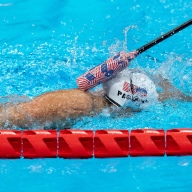
PARA CYCLING
The letter represents the type of bike, while the number represents the level of impairment (ie: the lower the number, the greater level of impairment).
C = Cycle
Standard cycle, with some modifications if required.
H = Handcycle
Operated by your hands, rather than your feet. For lower limb impairments that can't ride standard bikes.
T = Trike
Three-wheeled cycle. For those who have have an impairment that affects their balance.
B = Blind / Visual Impairment
Tandem cycle. The cyclist who is blind or has a visually impairment pedals from the back, while a sighted (able-bodied) cyclist steers and pedals from the front.
Cycle & Handcycling have classes 1-5. Trikes have classes 1-2, while Blind / Visual Impairment have just the 1 combined class. Competition is on the track and the road (Handcycling and Trikes are road only).
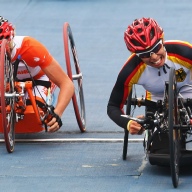
WHEELCHAIR RUGBY
Wheelchair rugby is a mixed gender team sport and was originally designed for tetraplegics as an alternative to wheelchair basketball. Over the years, other impairments to play the game include people with multiple amputations, muscular dystrophy or cerebral palsy.
Wheelchair rugby is played indoors with a volleyball. The aim of the game is to score tries by carrying the ball across the oppositions try line.
Players are classified 0.5 to 3.5 (the lower the number, the greater level of impairment). There can be four players per team on court at any one time and the total classification value cannot exceed eight points.
To encourage more females to play the game (it is mostly played by males), teams receive an additional 0.5 when a female player is on court.
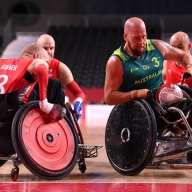
PARA ATHLETICS
T = Track
F = Field
11–13 Visual Impairments
20 Intellectual Impairments
31–34 Wheelchair or Seated Events
35–38 Ambulant Events
40–41 Short Stature
42–44 Lower Limb Impairments
45–47 Upper Limb Impairments
51–57 Wheelchair or Seated Events
61-64 Lower Limb Impairments (competing with prosthesis)
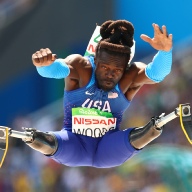
BOCCIA
This is played by individuals, pairs, or teams of three. All events are mixed gender. The aim of the game is to throw your ball (coloured red or blue) as close as you can to a white target ball (or jack).
BC = Boccia
1 = Players throw the ball with their hand or foot. They have more severe impairments and can be supported by an assistant.2 = Players throw the ball with their hand.3 = Players have severe impairments and may use a ramp to deliver the ball. They compete using an assistant, who must keep their back to the court.4 = Players throw the ball with their hand. Unlike classes 1-2, players have impairments that have no cerebral origin (ie: muscular dystrophy, spinal cord Injuries or amputations affecting all four limbs).
There is also a class 5, and in New Zealand, a Kiwi class. These are not at the Paralympic Games.
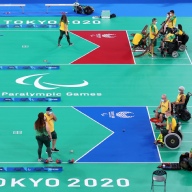
GOALBALL
This is played by athletes with visual impairments using a ball with bells inside. The game is played by two teams of three people on a court.
The aim is to score by rolling the ball at the opposition's goal, while the other team attempts to block the ball with their bodies. All players must wear blindfolds.
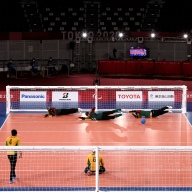
SITTING VOLLEYBALL
It is volleyball with a difference - players must remain sitting when playing the ball. The sitting version requires a smaller court (10m x 6m) and a lower net (1.15m for men, 1.05m for women).
There are two classes, VS1 and VS2 (the lower the number, the greater level of impairment).
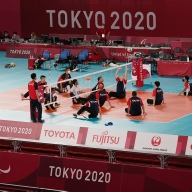
LOCATION
108 Sawyers Arms Road
Northcote, Christchurch 8052
POSTAL
PO Box 35 059
Shirley, Christchurch 8640
CONTACT
03 385 4449
info@parafedcanterbury.co.nz
 Admin Login
Admin Login